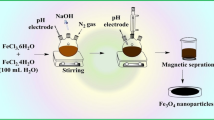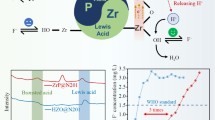Abstract
Magnetic Fe3O4@Cu/Ce microspheres were successfully prepared by one-step solvothermal approach and further utilized to remediate toxic arsenic (As(III)) pollution. The effects of Cu/Ce elements co-doping on the crystal structure, catalytic oxidation and adsorption behaviors of magnetic microspheres were researched systematically. The results showed that with the aid of Cu/Ce elements, the grain size reduced, lattice defects increased, and the oxygen vacancies and surface hydroxyl groups were improved. Therefore, Cu/Ce elements endowed magnetic Fe3O4@Cu/Ce microspheres with excellent As(III) removal performance, whose maximum adsorption capacity reached 139.19 mg/g. The adsorption mechanism mainly involved catalytic oxidant co-adsorption. This research developed a feasible strategy for the preparation of high efficiency magnetic adsorbent to enhance the removal of As(III).
摘要
本文通过一步溶剂法成功制备了磁性Fe3O4@Cu/Ce 微球,并将其应用于毒性重金属三价砷的 处理.系统考察了Cu/Ce 元素共掺杂对复合材料结构晶型、催化氧化性能以及对三价砷的去除性能的 影响.揭示了Cu/Ce 元素的共掺杂效应可以显著降低磁性微球的晶粒尺寸,增加晶格缺陷,提高氧空 缺位和丰富活性官能团.研究表明磁性Fe3O4@Cu/Ce 微球对重金属三价砷具有较强的去除性能,最 大吸附量可达139.19 mg/g.三价砷的去除机理主要涉及到催化氧化协同吸附,将三价砷氧化为五价砷 的同时将其吸附在微球上.本文提出了一种可行的高性能磁性复合材料的制备方法,为三价砷的处理 提供了技术思路
Similar content being viewed by others
References
SHAKOOR M B, NIAZI N K, BIBI I, SHAHID M, SAQIB Z A, NAWAZ M F, SHAHEEN S M, WANG H, TSANG D C W, BUNDSCHUH J, OK Y S, RINKLEBE J. Exploring the arsenic removal potential of various biosorbents from water [J]. Environment International, 2019, 123: 567–579. DOI: https://doi.org/10.1016/j.envint.2018.12.049.
XU Fang-nan, CHEN Hu-xing, DAI Yu-xia, WU Shuang-lei, TANG Xian-jin. Arsenic adsorption and removal by a new starch stabilized ferromanganese binary oxide in water [J]. Journal of Environment Management, 2019, 245: 160–167. DOI: https://doi.org/10.1016/j.jenvman.2019.05.071.
ASERE T G, STEVENS C V, DU LAING G. Use of (modified) natural adsorbents for arsenic remediation: A review [J]. Science of the Total Environment, 2019, 676: 706–720. DOI: https://doi.org/10.1016/j.scitotenv.2019.04.237.
SUN Tian-yi, ZHAO Zhi-wei, LIANG Zhi-jie, LIU Jie, SHI Wen-xin, CUI Fu-yi. Efficient degradation of p-arsanilic acid with arsenic adsorption by magnetic CuO-Fe3O4 nanoparticles under visible light irradiation [J]. Chemical Engineering Journal, 2018, 334: 1527–1536. DOI: https://doi.org/10.1016/j.cej.2017.11.052.
XI Yun-hao, ZOU Jing-tian, LUO Yong-guang, LI Jing, LI Xi-teng, LIAO Tian-qi, ZHANG Li-bo, WANG Chen, LIN Guo. Performance and mechanism of arsenic removal in waste acid by combination of CuSO4 and zero-valent iron [J]. Chemical Engineering Journal, 2019, 375: 121928. DOI: https://doi.org/10.1016/j.jcis.2018.02.046.
HE Xin-yu, DENG Fang, SHEN Ting-ting, YANG Li-ming, CHEN De-zhi, LUO Jian-feng, LUO Xu-biao, MIN Xiao-ye, WANG Fang. Exceptional adsorption of arsenic by zirconium metal-organic frameworks: Engineering exploration and mechanism insight [J]. Journal of Colloid and Interface Science, 2019, 539: 223–234. DOI: https://doi.org/10.1016/j.jcis.2018.12.065.
YU Yang, YU Ling, SHIH Kai-min, CHEN J P. Yttrium-doped iron oxide magnetic adsorbent for enhancement in arsenic removal and ease in separation after applications [J]. Journal of Colloid and Interface Science, 2018, 521: 252–260. DOI: https://doi.org/10.1016/j.jcis.2018.02.046.
NASIR A M, GOH P S, ISMAIL A F. Highly adsorptive polysulfone/hydrous iron-nickel-manganese (PSF/HINM) nanocomposite hollow fiber membrane for synergistic arsenic removal [J]. Separation and Purification Technology, 2019, 213: 162–175. DOI: https://doi.org/10.1016/j.seppur.2018.12.040.
CHEN M, SHAFER-PELTIER K, RANDTKE S J, PELTIER E. Modeling arsenic (V) removal from water by micellar enhanced ultrafiltration in the presence of competing anions [J]. Chemosphere, 2018, 213: 285–294. DOI: https://doi.org/10.1016/j.chemosphere.2018.09.046.
JAHROMI F G, GHAHREMAN A. In-situ oxidative arsenic precipitation as scorodite during carbon catalyzed enargite leaching process [J]. Journal of Hazardous Materials, 2018, 360: 631–638. DOI: https://doi.org/10.1016/j.jhazmat.2018.08.019.
CAI Gui-yuan, ZHU Xing, LI Kong-zhai, QI Xian-jin, WEI Yong-gang, WANG Hua, HAO Feng-yan. Self-enhanced and efficient removal of arsenic from waste acid using magnetite as an in situ iron donator [J]. Water Research, 2019, 157: 269–280. DOI: https://doi.org/10.1016/j.watres.2019.03.067.
WU Kun, JING Chun-yang, ZHANG Jin, LIU Ting, YANG Sheng-jiong, WANG Wen-dong. Magnetic Fe3O4@CuO nanocomposite assembled on graphene oxide sheets for the enhanced removal of arsenic(III/V) from water [J]. Applied Surface Science, 2019, 466: 746–756. DOI: https://doi.org/10.1016/j.apsusc.2018.10.091.
QI Peng-fei, LUO Rong, PICHLER T, ZENG Jian-qiang, WANG Yan, FAN Yu-hua, SUI Kun-yan. Development of a magnetic core-shell Fe3O4@TA@UiO-66 microsphere for removal of arsenic(III) and antimony(III) from aqueous solution [J]. Journal of Hazardous Materials, 2019, 378: 120721. DOI: https://doi.org/10.1016/j.jhazmat.2019.05.114.
WANG Hai-ying, HE Ying-jie, CHAI Li-yuan, LEI Huang, YANG Wei-chun, HOU Lan-jing, YUAN Tao, JIN Lin-feng, TANG Chong-jian, LUO Jian. Highly-dispersed Fe2O3@C electrode materials for Pb2+ removal by capacitive deionization [J]. Carbon, 2019, 153: 12–20. DOI: https://doi.org/10.1016/j.carbon.2019.06.066.
WU Jin, ZHU Hong-shan, LIU Ge, TAN Li-qiang, HU Xiao-ye, CHEN Chang-lun, ALHARBI N S, HAYAT T, TAN Xiao-li. Fabrication of core-shell CMNP@PmPD nanocomposite for efficient As(V) adsorption and reduction [J]. ACS Sustainable Chemistry & Engineering, 2017, 5(5): 4399–4407. DOI: https://doi.org/10.1021/acssuschemeng.7b00468.
WU Jin, CHEN Ke, TAN Xiao-li, FANG Ming, HU Xiao-ye, TANG Zhen-wu, WANG Xiang-ke. Core-shell CMNP@PDAP nanocomposites for simultaneous removal of chromium and arsenic [J]. Chemical Engineering Journal, 2018, 349: 481–490. DOI: https://doi.org/10.1016/j.cej.2018.05.114.
PENG Bing, SONG Ting-ting, WANG Ting, CHAI Li-yuan, YANG Wei-chun, LI Xiao-rui, LI Chao-fang, WANG Hai-ying. Facile synthesis of Fe3O4@Cu(OH)2 composites and their arsenic adsorption application [J]. Chemical Engineering Journal, 2016, 299: 15–22. DOI: https://doi.org/10.1016/j.cej.2016.03.135.
XIE Wu-ming, ZHOU Feng-ping, BI Xiao-lin, CHEN Dong-dong, HUANG Zi-jun, LI Yu-hui, SUN Shui-yu, LIU Jing-yong. Decomposition of nickel(II)-ethylenediaminetetraacetic acid by fenton-like reaction over oxygen vacancies-based Cu-doped Fe3O4@γ-Al2O3 catalyst: A synergy of oxidation and adsorption [J]. Chemosphere, 2019, 221: 563–572. DOI: https://doi.org/10.1016/j.chemosphere.2019.01.083.
AASHIMA A, UPPAL S, ARORA A, GAUTAM S, SINGH S, CHOUDHARY R J, MEHTA S K. Magnetically retrievable Ce-doped Fe3O4 nanoparticles as scaffolds for the removal of azo dyes [J]. RSC Advances, 2019, 9(40): 23129–23141. DOI: https://doi.org/10.1039/C9RA03252E.
GOGOI A, NAVGIRE M, SARMA K C, GOGOI P. Fe3O4-CeO2 metal oxide nanocomposite as a Fenton-like heterogeneous catalyst for degradation of catechol [J]. Chemical Engineering Journal, 2017, 311: 153–162. DOI: https://doi.org/10.1016/j.cej.2016.11.086.
MORETTI E, STORARO L, TALON A, RIELLO P, MOLINA A I, RODRÍGUEZ-CASTELLÓ N E. 3-D flower like Ce-Zr-Cu mixed oxide systems in the CO preferential oxidation (CO-PROX): Effect of catalyst composition [J]. Applied Catalysis B: Environmental, 2015, 168–169: 385–395. DOI: https://doi.org/10.1016/j.apcatb.2014.12.032.
ZHANG Yan-ping, FLYTZANI-STEPHANOPOULOS M. Hydrothermal stability of cerium modified Cu-ZSM-5 catalyst for nitric oxide decomposition [J]. Journal of Catalysis, 1996, 164: 131–145. DOI: https://doi.org/10.1006/jcat.1996.0369.
CAI Wei, ZHONG Qin, YU Yang, DAI Sheng. Correlation of morphology with catalytic performance of CrOxZCe0.2Zr0.8O2 catalysts for NO oxidation via in-situ STEM [J]. Chemical Engineering Journal, 2016, 288: 238–245. DOI: https://doi.org/10.1016/j.cej.2015.12.009.
JAMPAIAH D, IPPOLITO S J, SABRI Y M, REDDY B M, BHARGAVA S K. Highly efficient nanosized Mn and Fe codoped ceria-based solid solutions for elemental mercury removal at low flue gas temperatures [J]. Catalysis Science Technology, 2015(5): 2913–2924. DOI: https://doi.org/10.1039/C5CY00231A.
PENG Cong, CHAI Li-yuan, TANG Chong-jian, MIN Xiao-bo, SONG Yu-xia, DUAN Cheng-shan, YU Cheng. Study on the mechanism of copper-ammonia complex decomposition in struvite formation process and enhanced ammonia and copper removal [J]. Journal of Environmental Sciences, 2017, 51: 222–233. DOI: https://doi.org/10.1016/j.jes.2016.06.020.
CHOU M H, LIU S B, HUANG C Y, WU S Y, CHENG C L. Confocal Raman spectroscopic mapping studies on a single CuO nanowire [J]. Applied Surface Science, 2008, 254(23): 7539–7543. DOI: https://doi.org/10.1016/j.apsusc.2007.12.065.
THI T M, TRANG N T H, van ANH N T. Effects of Mn, Cu doping concentration to the properties of magnetic nanoparticles and arsenic adsorption capacity in wastewater [J]. Applied Surface Science, 2015, 340: 166–172. DOI: https://doi.org/10.1016/j.apsusc.2015.02.132.
YEN H, SEO Y, KALIAGUINE S, KLEITZ F. Tailored mesostructured copper/ceria catalysts with enhanced performance for preferential oxidation of CO at low temperature [J]. Angewandte Communications, 2012, 51(48): 12032–12035. DOI: https://doi.org/10.1002/anie.201206505.
MALLESHAM B, SUDARSANAM P, REDDY B, VENKAT S, REDDY B M. Development of cerium promoted copper-magnesium catalysts for biomass valorization: Selective hydrogenolysis of bioglycerol [J]. Applied Catalysis B: Environmental, 2016, 181: 47–57. DOI: https://doi.org/10.1016/j.apcatb.2015.07.037.
SCHAUB R, THOSTRUP P, LOPEZ N, LAEGSGAARD E, STENSGAARD I, NORSKOV J K, BESENBACHER F. Oxygen vacancies as active sites for water dissociation on rutile TiO2(110) [J]. Physical Review Letters, 2001, 87(26): 266104. DOI: https://doi.org/10.1103/PhysRevLett.87.266104.
CAI Mei-qiang, ZHU Yi-zu, WEI Zong-su, HU Jian-qiang, PAN Sheng-dong, XIAO Rui-yang, DONG Chun-ying, JIN Mi-cong. Rapid decolorization of dye orange G by microwave enhanced fenton-like reaction with delafossite-type CuFeO2 [J]. Science of the Total Environment, 2017, 580: 966–973. DOI: https://doi.org/10.1016/j.scitotenv.2016.12.047.
JIN Lin-feng, CHAI Li-yuan, REN Li-li, JIANG Yu-xin, YANG Wei-chun, WANG Sheng, LIAO Qi, WANG Hai-ying, ZHANG Li-yuan. Enhanced adsorption-coupled reduction of hexavalent chromium by 2D poly(m-phenylenediamine)-functionalized reduction graphene oxide [J]. Environ Sci Pollut R, 2019, 26(30): 31099–31110. DOI: https://doi.org/10.1007/s11356-019-06175-x.
WANG Ting, ZHANG Li-yuan, LI Chao-fang, YANG Wei-chun, SONG Ting-ting, TANG Chong-jian, MENG Yun, DAI Shuo, WANG Hai-ying, CHAI Li-yuan, LUO Jian. Synthesis of core-shell magnetic Fe3O4@poly(m-Phenylenediamine) particles for chromium reduction and adsorption [J]. Environmental Science and Technology, 2015, 49(9): 5654–5662. DOI: https://doi.org/10.1021/es5061275.
SHAN Chao, TONG Mei-ping. Efficient removal of trace arsenite through oxidation and adsorption by magnetic nanoparticles modified with Fe-Mn binary oxide [J]. Water Research, 2013, 47(10): 3411–3421. DOI: https://doi.org/10.1016/j.watres.2013.03.035.
GUPTA K, BHATTACHARYA S, NANDI D, DHAR A, MAITY A, MUKHOPADHYAY A, CHATTOPADHYAY D J, RAY N R, SEN P, GHOSH U C. Arsenic(III) sorption on nanostructured cerium incorporated manganese oxide (NCMO): A physical insight into the mechanistic pathway [J]. Journal of Colloid and Interface Science, 2012, 377(1): 269–276. DOI: https://doi.org/10.1016/j.jcis.2012.01.066.
DHOBLE R M, LUNGE S, BHOLE A G, RAYALU S. Magnetic binary oxide particles (MBOP): A promising adsorbent for removal of As (III) in water [J]. Water Research, 2011, 45(16): 4769–4781. DOI: https://doi.org/10.1016/j.watres.2011.06.016.
LIN Sen, LU Dian-nan, LIU Zheng. Removal of arsenic contaminants with magnetic y-Fe2O3 nanoparticles [J]. Chemical Engineering Journal, 2012, 211–212: 46–52. DOI: https://doi.org/10.1016/j.cej.2012.09.018.
YU Lian, PENG Xian-jia, NI Fan, LI Jin, WANG Dong-sheng, LUAN Zhao-kun. Arsenite removal from aqueous solutions by gamma-Fe2O3-TiO2 magnetic nanoparticles through simultaneous photocatalytic oxidation and adsorption [J]. Journal of Hazardous Materials, 2013, 246–247: 10–17. DOI: https://doi.org/10.1016/j.jhazmat.2012.12.007.
JIN Lin-feng, HUANG Lei, REN Li-li, HE Ying-jie, TANG Jing-wen, WANG Sheng, YANG Wei-chun, WANG Hai-ying, CHAI Li-yuan. Preparation of stable and high-efficient poly(m-phenylenediamine)/reduced graphene oxide composites for hexavalent chromium removal [J]. J Mater Sci, 2019, 54(1): 383–395. DOI: https://doi.org/10.1007/s10853-018-2844-9.
PENG Cong, CHAI Li-yuan, SONG Yu-xia, MIN Xiao-bo, TANG Chong-jian. Thermodynamics, kinetics and mechanism analysis of Cu(II) adsorption by in-situ synthesized struvite crystal [J]. Journal of Central South University, 2018, 25(5): 1033–1042. DOI: https://doi.org/10.1007/s11771-018-3803-y.
HABIBA U, AFIFI A M, SALLEH A, ANG B C. Chitosan/(polyvinyl alcohol)/zeolite electrospun composite nanofibrous membrane for adsorption of Cr6+, Fe3+ and Ni2+ [J]. Journal of Hazardous Materials, 2017, 322(Pt A): 182–194. DOI: https://doi.org/10.1016/j.jhazmat.2016.06.028.
WANG Teng, LI Cai-ting, ZHAO Ling-kui, ZHANG Jun-yi, LI Shan-hong, ZENG Guang-ming. The catalytic performance and characterization of ZrO2 support modification on CuO-CeO2/TiO2 catalyst for the simultaneous removal of Hg0 and NO [J]. Applied Surface Science, 2017, 400: 227–237. DOI: https://doi.org/10.1016/j.apsusc.2016.12.192.
WANG Ting, ZHANG Li-yuan, WANG Hai-ying, YANG Wei-chun, FU Ying-chun, ZHOU Wen-li, YU Wan-ting, XIANG Kai-song, SU Zhen, DAI Sshuo, CHAI Li-yuan. Controllable synthesis of hierarchical porous Fe3O4 particles mediated by poly(diallyldimethylammonium chloride) and their application in arsenic removal [J]. ACS Applied Materials Interfaces, 2013, 5(23): 12449–12459. DOI: https://doi.org/10.1021/am403533v.
WEN Zhi-pan, ZHANG Ya-lei, WANG Yu, LI Li-na, CHEN Rong. Redox transformation of arsenic by magnetic thin-film MnO2 nanosheet-coated flowerlike Fe3O4 nanocomposites [J]. Chemical Engineering Journal, 2017, 312: 39–49. DOI: https://doi.org/10.1016/j.cej.2016.11.112.
Author information
Authors and Affiliations
Corresponding author
Additional information
Foundation item: Project(2018YFC1802204) supported by the National Key R&D Program of China; Project(51634010) supported by the Key Project of National Natural Science Foundation of China; Project(2018SK2026) supported by the Key R&D Program of Hunan Province, China
Rights and permissions
About this article
Cite this article
Jin, Lf., Chai, Ly., Song, Tt. et al. Preparation of magnetic Fe3O4@Cu/Ce microspheres for efficient catalytic oxidation co-adsorption of arsenic(III). J. Cent. South Univ. 27, 1176–1185 (2020). https://doi.org/10.1007/s11771-020-4358-2
Received:
Accepted:
Published:
Issue Date:
DOI: https://doi.org/10.1007/s11771-020-4358-2




